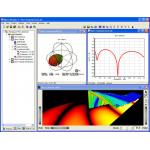Latest News
September 1, 2005
The new Version 7 of MicroStripes electromagnetic design simulation software from Flomerics (Marlborough, MA) automatically runs a series of simulations while varying one or more design parameters over a user-specified range. Supplemented this feature are improvements in the accuracy of the automatic meshing algorithm, and V7 enables users to inspect simulation results more quickly by simply running their mouse over the graphical output.
By allowing users to substitute variables for design parameters, V7 speeds up the design process significantly, says Flomerics. Users model their concept design, identify geometric entities as variables, pick upper and lower limits for each variable, and select a step size. MicroStripes then generates as many simulation iterations as are required to completely explore the user-defined design space. The results of each simulation are plotted on a single graph so users can quickly determine which design parameter values provide optimal performance.
|
|
|
MicroStripes Version 7 enables rapid tuning of electromagnetic devices such as this horn antenna.
|
The automatic meshing algorithm in V7 automatically mimics what experienced users do when they manually fine-tune the mesh. The result is V7 eliminates the need for such fine-tuning, allowing automatically generated meshes to be used for nearly all simulations. The accuracy of the results produced by automatically generated meshes is now equivalent to that produced by hand-tuned meshes in the vast majority of cases, says the company.
Results visualization in V7 has been improved to allow engineers to access the information they need to optimize their design more quickly. Running the mouse over a radiation pattern graph, for example, now yields the radiation magnitude at each point. Likewise, moving over electromagnetic field output produces field magnitude at any given point. The radiation pattern display has also been improved to directly show the antenna efficiency and gain. Polarization schemes can now be changed with a single click of the mouse.
MicroStripes uses the Transmission Line Matrix (TLM) method for solving Maxwell's equations. A key advantage of the TLM method when applied to antenna design is that it solves for all frequencies of interest in a single calculation and therefore captures the full broadband response of the system in one simulation cycle. A further advantage is that the TLM method creates a matrix of equivalent transmission lines and solves for voltage and current on these lines directly. This uses less memory and CPU time than solving for E and H fields on a conventional computational grid.
MicroStripes 7 is now available for all 64-bit Windows editions (x64 and Itanium). On these platforms, it comes with a 64-bit solver capable of solving problems requiring over 2Gbytes of memory. For complete details, click here.
Subscribe to our FREE magazine, FREE email newsletters or both!
Latest News
About the Author
DE’s editors contribute news and new product announcements to Digital Engineering.
Press releases may be sent to them via [email protected].







